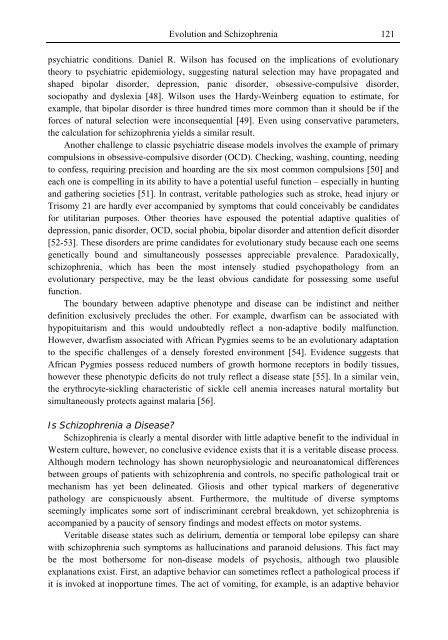Schizophrenia Research Trends
Schizophrenia Research Trends
Schizophrenia Research Trends
- No tags were found...
You also want an ePaper? Increase the reach of your titles
YUMPU automatically turns print PDFs into web optimized ePapers that Google loves.
Evolution and <strong>Schizophrenia</strong> 121psychiatric conditions. Daniel R. Wilson has focused on the implications of evolutionarytheory to psychiatric epidemiology, suggesting natural selection may have propagated andshaped bipolar disorder, depression, panic disorder, obsessive-compulsive disorder,sociopathy and dyslexia [48]. Wilson uses the Hardy-Weinberg equation to estimate, forexample, that bipolar disorder is three hundred times more common than it should be if theforces of natural selection were inconsequential [49]. Even using conservative parameters,the calculation for schizophrenia yields a similar result.Another challenge to classic psychiatric disease models involves the example of primarycompulsions in obsessive-compulsive disorder (OCD). Checking, washing, counting, needingto confess, requiring precision and hoarding are the six most common compulsions [50] andeach one is compelling in its ability to have a potential useful function – especially in huntingand gathering societies [51]. In contrast, veritable pathologies such as stroke, head injury orTrisomy 21 are hardly ever accompanied by symptoms that could conceivably be candidatesfor utilitarian purposes. Other theories have espoused the potential adaptive qualities ofdepression, panic disorder, OCD, social phobia, bipolar disorder and attention deficit disorder[52-53]. These disorders are prime candidates for evolutionary study because each one seemsgenetically bound and simultaneously possesses appreciable prevalence. Paradoxically,schizophrenia, which has been the most intensely studied psychopathology from anevolutionary perspective, may be the least obvious candidate for possessing some usefulfunction.The boundary between adaptive phenotype and disease can be indistinct and neitherdefinition exclusively precludes the other. For example, dwarfism can be associated withhypopituitarism and this would undoubtedly reflect a non-adaptive bodily malfunction.However, dwarfism associated with African Pygmies seems to be an evolutionary adaptationto the specific challenges of a densely forested environment [54]. Evidence suggests thatAfrican Pygmies possess reduced numbers of growth hormone receptors in bodily tissues,however these phenotypic deficits do not truly reflect a disease state [55]. In a similar vein,the erythrocyte-sickling characteristic of sickle cell anemia increases natural mortality butsimultaneously protects against malaria [56].Is <strong>Schizophrenia</strong> a Disease?<strong>Schizophrenia</strong> is clearly a mental disorder with little adaptive benefit to the individual inWestern culture, however, no conclusive evidence exists that it is a veritable disease process.Although modern technology has shown neurophysiologic and neuroanatomical differencesbetween groups of patients with schizophrenia and controls, no specific pathological trait ormechanism has yet been delineated. Gliosis and other typical markers of degenerativepathology are conspicuously absent. Furthermore, the multitude of diverse symptomsseemingly implicates some sort of indiscriminant cerebral breakdown, yet schizophrenia isaccompanied by a paucity of sensory findings and modest effects on motor systems.Veritable disease states such as delirium, dementia or temporal lobe epilepsy can sharewith schizophrenia such symptoms as hallucinations and paranoid delusions. This fact maybe the most bothersome for non-disease models of psychosis, although two plausibleexplanations exist. First, an adaptive behavior can sometimes reflect a pathological process ifit is invoked at inopportune times. The act of vomiting, for example, is an adaptive behavior
















